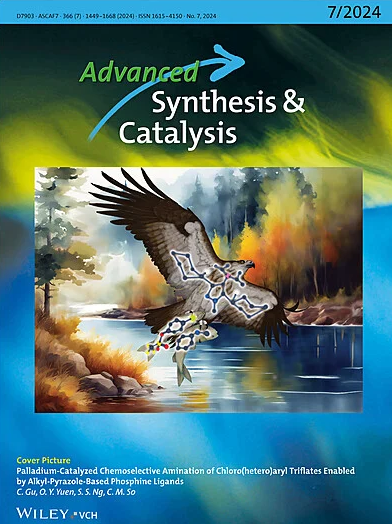Visible‐Light‐Induced Stereoselective C(sp3)−C(sp3)−H Glycosylation for the Synthesis of C‐Glycoamino Acid Derivatives
IF 4.4
2区 化学
Q2 CHEMISTRY, APPLIED
引用次数: 0
Abstract
Chiral C‐Glycosyl amino acids are prevalent structural motifs found in pharmaceuticals and natural products, making them a significant dimension for exploration in modern pharmaceutical and medicinal chemistry. However, the current synthesis methods for these compounds face numerous environmental and practical challenges, highlighting the critical need to establish more sustainable approaches. Herein, we report a simple and powerful strategy for the stereoselective synthesis of C‐glycoamino acids derivatives. This method features the design and use of (−)/(+)‐camphorsultam as an ideal chiral auxiliary, shielding one prochiral face of the glycine α‐carbon efficiently and imposing a high kinetic barrier for the epimerization of thus‐generated chiral α‐carbon that two configuration products of R and S could be achieved independently. It proceeds under mild conditions, shows broad scope, and allows for the direct stereoselective glycosylation without metal and chiral ligand.
可见光诱导的立体选择性 C(sp3)-C(sp3)-H 糖基化合成 C-氨基乙酸衍生物
手性 C-糖基氨基酸是药物和天然产物中普遍存在的结构基团,使其成为现代药物和医药化学探索的一个重要方面。然而,目前合成这些化合物的方法面临着许多环境和实际挑战,因此迫切需要建立更可持续的方法。在此,我们报告了一种简单而强大的立体选择性合成 C-甘氨酸的策略。该方法的特点是设计并使用 (-)/(+)- 樟脑磺胺作为理想的手性助剂,有效地屏蔽了甘氨酸 α 碳的一个亲手性面,并对由此生成的手性 α 碳的外嵌化施加了很高的动力学障碍,使 R 和 S 两种构型产物可以独立实现。该方法在温和的条件下进行,具有广阔的应用范围,可以在不使用金属和手性配体的情况下直接进行立体选择性糖基化。
本文章由计算机程序翻译,如有差异,请以英文原文为准。
求助全文
约1分钟内获得全文
求助全文
来源期刊

Advanced Synthesis & Catalysis
化学-应用化学
CiteScore
9.40
自引率
7.40%
发文量
447
审稿时长
1.8 months
期刊介绍:
Advanced Synthesis & Catalysis (ASC) is the leading primary journal in organic, organometallic, and applied chemistry.
The high impact of ASC can be attributed to the unique focus of the journal, which publishes exciting new results from academic and industrial labs on efficient, practical, and environmentally friendly organic synthesis. While homogeneous, heterogeneous, organic, and enzyme catalysis are key technologies to achieve green synthesis, significant contributions to the same goal by synthesis design, reaction techniques, flow chemistry, and continuous processing, multiphase catalysis, green solvents, catalyst immobilization, and recycling, separation science, and process development are also featured in ASC. The Aims and Scope can be found in the Notice to Authors or on the first page of the table of contents in every issue.
 求助内容:
求助内容: 应助结果提醒方式:
应助结果提醒方式:


